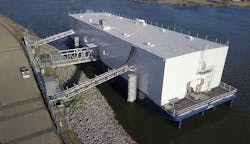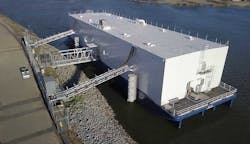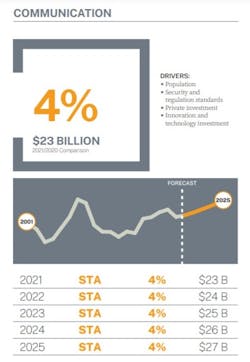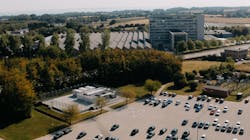Propelled by virtually every industry's long-running big data explosion, the global engineering and construction market for data centers had been growing steadily before the pandemic. The only thing that appeared able to hold it back was the market's seemingly insatiable thirst for water and energy.
In other words, this futuristic market was at odds with sustainability, itself, the very practice of preserving the future.
Then, of course, the global COVID-19 pandemic hit in early 2020, and just about every type of new construction stopped in its tracks.
But now, as the pandemic finally seems to be subsiding in the U.S., data center construction appears poised to recapture its 2019 momentum and promise. This time, however, more energy-friendly practices may allow the market to achieve unfettered momentum.
Last month in Northern California, for instance, Nautilus Data Technologies launched what it claims is "the world's first zero-water consumption commercial data center," a waterborne facility housed on the deck of a barge in the Port of Stockton on the San Joaquin River. It seeks to tap rivers, lakes and oceans to slash the cost of cooling its servers, the company says.
“The rapidly growing data center sector is just as rapidly on the way to becoming utterly unsustainable,” said Nautilus CEO James Connaughton in an April interview with Data Center Frontier. “Nautilus can reverse that. We want to make this technology as widely available as possible to sustainably help close the digital divide.”
Toward that end, Nautilus retained engineering giant Black & Veatch to conduct a third-party due diligence report and oversee commissioning at the new 7-Mw Stock data center. The Overland Park KS-based firm verified the cooling, electrical and machinery systems functioned as designed. “In a time where water scarcity is an issue in many areas, and energy costs continue to rise, it was exciting to help launch this highly sustainable solution,” said Katie Schultz, Director of Data Center Services at Black & Veatch. The innovation allows the owner "to efficiently operate data centers with minimal environmental impact," she added.
According to Nautilus, its commercial data centers use TRUE™ (Total Resource Usage Effectiveness) technology to recirculate water from a nearby ocean, river or lake to cool the data center environment. Utilizing a body of water as a heat sink, the facility consumes no water, produces no wastewater, and requires no refrigerants or water treatment chemicals, cooling towers, or computer room air handlers, the company says.
During commissioning of the first of four data halls in Stockton, the IT equipment load was observed at 1.45 Mw. At this load, the room temperature remained consistent at 73 degrees. When power was switched to the generator, the room remained cool and power to IT was continuous. “Commissioning was the final step in bringing our vision of delivering an energy and cost-efficient data center to the market,” explained Nautilus President Rob Pfleging. Now, Nautilus can "begin accepting new tenants who value energy efficiency, sustainability and scalability,” he added.
Sustaining data more sustainably
"Focusing on sustainability issues will be a big trend in 2021," said Ernest Sampera, SVP at vXchnge, a Tampa FL-based colocation consultant for data centers. Writing on his blog in February, he explained, "Not only are regions where data centers are located starting to concentrate on water usage, but energy consumption and emissions are also a growing concern. In response, expect many data centers to start investing in renewable resources and discussions to focus on this industry challenge. Look for data centers to find ways to not only reduce their impact on the environment, but also ways to help other sectors as well, as with waste heat recycling."
"In 2020, communications infrastructure became the foundation on which our economy survived, grew and evolved as it supported connectivity and e-commerce across nearly all aspects of our personal and working lives," observed industry consultant FMI Corp. in a recent pulse check on the U.S. economy. "Retail, remote business, remote learning, health care, connected devices, etc., all depend on reliable communications infrastructure."
As a result, FMI is predicting steady growth for this market, at least through 2025. "Spending growth will remain stable, supported by government stimulus and infrastructure funding for system expansion and hardening," says the firm's Second Quarter 2021 report. "5G and other network technologies continue to drive new opportunities for device and data integration. Investment demand overlaps with growth across data centers, distribution and logistics spending."
Tech and logistics giants Google, Microsoft and Amazon will lead this push, both in the U.S. and across the globe. And sustainability issues will be ever-present.
In February, for instance, HVAC equipment manufacturer Danfoss announced, "In response to the exponential growth of data-center energy consumption, Danfoss (has) decided to build data centers that will be an example for future climate-friendly designs. Danfoss has the technologies to cool data centers in a greener way, to reduce energy consumption within them, and to reuse the excess heat for other applications."
To illlustrate this point, the multinational firm made an example of its headquarters in Nordborg, Denmark. In 2015, that facility was heated 100% by fossil fuel. But next year, it will be carbon neutral. And, in 2024, reused excess heat from Danfoss data centers will provide 25% of the overall heat supply for the 250,000 square meters (2.69 million square feets) of factories and offices that they service.
”Using the latest technologies for cooling and heat recovery, we transform data centers from energy consumers to sources of sustainable energy. It is exciting to see that in action at our own data centers,” said Jürgen Fischer, President, Danfoss Climate Solutions..
Location plays a key factor to optimally utilize excess heat. The data center will be near the location of data use and where the local area can benefit from the excess heat. This provides the opportunity to use oil-free heat-pump systems to transform the data center into a heat source. The excess heat from the data center can then be distributed to a local neighborhood, helping to reduce the data-center energy costs, and lowering greenhouse gas emissions.
“The data centers of the future will be hybrid data centers where we combine the best of two worlds: the cloud and the on-site data center. And we utilize the excess heat in the energy grids close to where it is produced,” Danfoss CIO Sune T. Baastrup said.
Danfoss is on a digital transformation journey, Baastrup added, consolidating 20 global data centers and 135 server rooms into a handful of data centers, which will all be built utilizing Danfoss green technologies.
Data centers are consuming vast amounts of energy. Energy to supply servers with power, but also to cool down server rooms and remove the huge amounts of heat they generate. It is estimated that 10 percent of all electricity is used within the IT ecosystem. This makes reducing the climate impact of digitalization a high priority, says Danfoss.
And as this trend grows post-pandemic, driven by the deep pockets of the tech and logistics giants, look for even more options in the marketplace to make the ongoing data revolution a net-plus for the environment, as well.
##########
About the Author
Rob McManamy
Editor in Chief
An industry reporter and editor since 1987, McManamy joined HPAC Engineering in September 2017, after three years with BuiltWorlds.com, a Chicago-based media startup focused on tech innovation in the built environment. He has been covering design and construction issues for more than 30 years, having started at Engineering News-Record (ENR) in New York, before becoming its Midwest Bureau Chief in 1990. In 1998, McManamy was named Editor-in-Chief of Design-Build magazine, where he served for four years. He subsequently worked as an editor and freelance writer for Building Design + Construction and Public Works magazines.
A native of Bronx, NY, he is a graduate of both the University of Virginia, and The John Marshall Law School in Chicago.
Contact him at [email protected].



